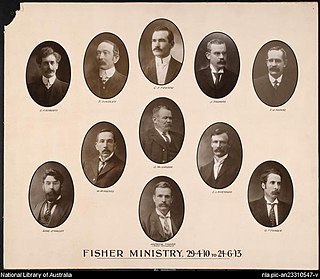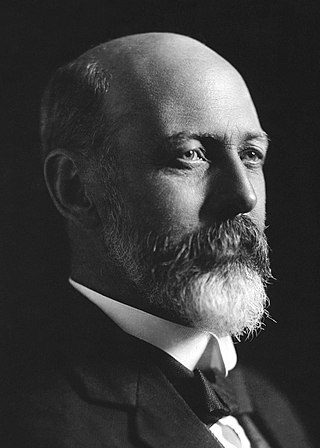The Liberal Party was a parliamentary party in Australian federal politics between 1909 and 1917. The party was founded under Alfred Deakin's leadership as a merger of the Protectionist Party and Anti-Socialist Party, an event known as the Fusion.

The Second Fisher ministry was the 8th ministry of the Government of Australia. It was led by the country's 5th Prime Minister, Andrew Fisher. The Second Fisher ministry succeeded the Third Deakin ministry, which dissolved on 29 April 1910 following the federal election that took place on 13 April which saw Labor defeat the Alfred Deakin's Liberal Party. It is the first federal government in Australian history to be elected with a majority in the House of Representatives, as well as the first majority national Labor government in the world. The ministry was replaced by the Cook ministry on 24 June 1913 following the federal election that took place in May which saw the Liberals defeat Labor.

Hugh Mahon was an Australian politician. He was a member of the Australian Labor Party (ALP) and held ministerial office in the party's earliest governments. He served terms as Postmaster-General (1904), Minister for Home Affairs (1908–1909), and Minister for External Affairs (1914–1916). However, Mahon is chiefly known as the only person to be expelled from the Parliament of Australia, for making "seditious and disloyal utterances" about the British Empire. He failed to win his seat back at the by-election.

William Arthur Holman was an Australian politician who served as Premier of New South Wales from 1913 to 1920. He came to office as the leader of the Labor Party, but was expelled from the party in the split of 1916. He subsequently became the inaugural leader of the NSW branch of the Nationalist Party.
This is a list of the members of the Australian House of Representatives in the Fifth Australian Parliament, which was elected on 31 May 1913.

Crawford Vaughan was an Australian politician, and the Premier of South Australia from 1915 to 1917. He was a member of the South Australian House of Assembly from 1905 to 1918, representing Torrens (1905–1915) and Sturt (1915–1918). Elected for the United Labor Party, he served as Treasurer in the Verran government, succeeded Verran as Labor leader in 1913, and was elected Premier after the Labor victory at the 1915 state election.

John Verran was an Australian politician and trade unionist. He served as premier of South Australia from 1910 to 1912, the second member of the Australian Labor Party (ALP) to hold the position.

The 1913 Australian federal election was held in Australia on 31 May 1913. All 75 seats in the House of Representatives, and 18 of the 36 seats in the Senate were up for election. The incumbent Labor Party, led by Prime Minister Andrew Fisher, was defeated by the opposition Commonwealth Liberal Party under Joseph Cook, marking the second time an Australian Prime Minister was defeated at an election. The new government had a majority of just a single seat, and held a minority of seats in the Senate. It would last only 15 months, suffering defeat at the 1914 election.

The 1910 Australian federal election was held in Australia on 13 April 1910. All 75 seats in the House of Representatives, and 18 of the 36 seats in the Senate were up for election. The incumbent Liberal Party led by Prime Minister Alfred Deakin was defeated by the opposition Australian Labor Party (ALP) led by Andrew Fisher.

Charles Edward Frazer was an Australian politician. He served in the House of Representatives from 1903 until his death from pneumonia in 1913, aged 33. He was Postmaster-General in the second Fisher Ministry.

The 1913 Tasmanian state election was held on Thursday, 23 January 1913 in the Australian state of Tasmania to elect 30 members of the Tasmanian House of Assembly. The election used the Hare-Clark proportional representation system — six members were elected from each of five electorates.
This is a list of members of the Western Australian Legislative Assembly between the 1911 election and the 1914 election, together known as the Eighth Parliament. All members who sat as Liberals, apart from those returned at by-elections, were elected under the "Ministerial" designation at the 1911 election.
This article provides information on candidates who stood for the 1914 Australian federal election. The election was held on 5 September 1914.

State elections were held in South Australia on 27 March 1915. All 46 seats in the South Australian House of Assembly were up for election. The incumbent Liberal Union government led by Premier of South Australia Archibald Peake was defeated by the opposition United Labor Party led by Leader of the Opposition Crawford Vaughan. Each district elected multiple members, with voters casting multiple votes.
Members of the New South Wales Legislative Assembly who served in the 23rd parliament of New South Wales held their seats from 1913 to 1917. They were elected at the 1913 state election on 6 December 1913. The Speaker was Richard Meagher.
Members of the New South Wales Legislative Council who served from 1913 to 1917 were appointed for life by the Governor on the advice of the Premier. This list includes members between the election on 6 December 1913 and the election on 24 March 1917. The President was Sir Francis Suttor until his death in April 1915 and then Fred Flowers.

The Australian Labor Party held a leadership spill on 8 July 1913, following the party's defeat at the May 1913 federal election. Andrew Fisher was re-elected to the leadership, defeating William Higgs. It was the first occasion on which a sitting leader had faced a challenge.
Enmore, an electoral district of the Legislative Assembly in the Australian state of New South Wales had two incarnations, from 1913 to 1920 and from 1927 until 1930.
Bingara, an electoral district of the Legislative Assembly in the Australian state of New South Wales was created in 1894 and abolished in 1920.









